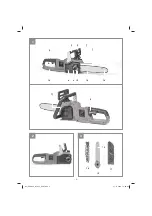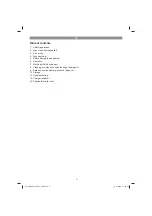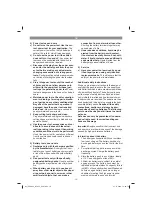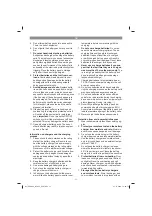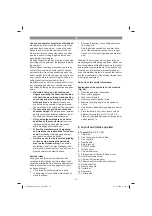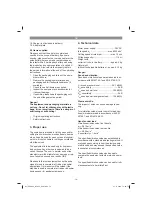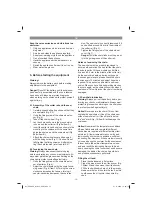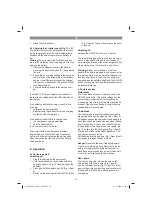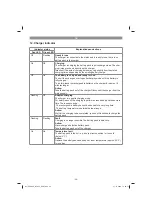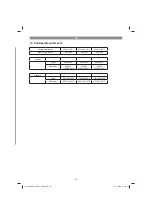
GB
- 13 -
Causes and operator prevention of kickback:
Kickback may occur when the nose or tip of the
guide bar touches an object, or when the wood
closes in and pinches the saw chain in the cut.
Tip contact in some cases may cause a sudden
reverse reaction, kicking the guide bar up and
back towards the operator.
Pinching the saw chain along the top of the guide
bar may push the guide bar rapidly back towards
the operator.
Either of these reactions may cause you to lose
control of the saw which could result in serious
personal injury. Do not rely exclusively upon the
safety devices built into your saw. As a chain saw
user, you should take several steps to keep your
cutting jobs free from accident or injury.
Kickback is the result of tool misuse and/or incor-
rect operating procedures or conditions and can
be avoided by taking proper precautions as given
below:
•
Maintain a firm grip, with thumbs and
fingers encircling the chain saw handles,
with both hands on the saw and position
your body and arm to allow you to resist
kickback forces.
Kickback forces can be
controlled by the operator, if proper precau-
tions are taken. Do not let go of the chain saw.
•
Do not overreach and do not cut above
shoulder height.
This helps prevent uninten-
ded tip contact and enables better control of
the chain saw in unexpected situations.
•
Only use replacement bars and chains
specified by the manufacturer.
Incorrect
replacement bars and chains may cause
chain breakage and/or kickback.
•
Follow the manufacturer’s sharpening
and maintenance instructions for the saw
chain.
Decreasing the depth gauge height
can lead to increased kickback.
•
Hold the power tool by insulated gripping
surfaces only, because the saw chain
may contact hidden wiring.
Saw chains
contacting a “live” wire may make exposed
metal parts of the power tool “live” and could
give the operator an electric shock.
Residual risks
Even if you use this electric power tool in ac-
cordance to instructions, certain residual risks
cannot be eliminated. The following hazards may
arise in connection with the equipment’s const-
ruction and layout:
•
Cut injuries if no safety clothing is used.
•
Lung damage if no suitable protective dust
mask is applied.
•
Damage to hearing if no suitable ear protec-
tion is applied.
•
Health damage caused by hand-arm vibra-
tions if the equipment is used over a longer
period or is not properly guided and maintai-
ned.
Warning! The electric power tool generates an
electromagnetic
fi
eld during operation. Under cer-
tain circumstances this
fi
eld may actively or passi-
vely impede medical implants. To reduce the risk
of serious or fatal injuries, we recommend per-
sons with medical implants to consult their doctor
and the manufacturer of the medical implant prior
to using the equipment.
Do not lose this safety information.
Explanation of the symbols on the machine
(Fig. 28):
1. Read the operating instructions.
2. Wear safety goggles.
3. Wear ear protectors.
4. Never expose the device to rain.
5. Maximum cutting length / chain speed vu:
15 m/s
6. Unlock chain brake before putting into opera-
tion!
7. Store the battery only in dry rooms with an
ambient temperature of +10°C to +40°C.
Place only charged batteries in storage (char-
ged at least 40%).
2. Layout and items supplied
2.1 Layout (Fig. 1-3, 11, 12)
1. Claw stop
2. Front hand guard (chain brake)
3. Front handle
4. Rear handle
5. Safety lock-o
ff
6. ON/OFF switch
7. Oil tank cover
8. Chain wheel cover
9. Fixing screw for the chain wheel cover
10. Chain tensioning screw
11. Chain oil
fi
ll level indicator
12. Battery pack (not included in delivery)
13. Pushlock button
14. Rear hand guard
15. Cutter bar
16. Saw chain
17. Cutter guard
Anl_PXCCSS_0182U_SPK7.indb 13
Anl_PXCCSS_0182U_SPK7.indb 13
27.11.2019 14:48:14
27.11.2019 14:48:14


